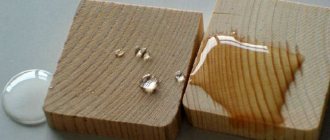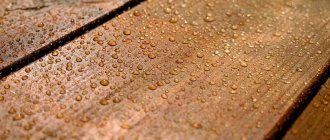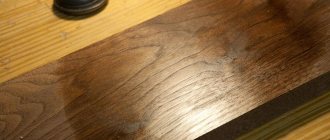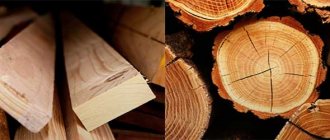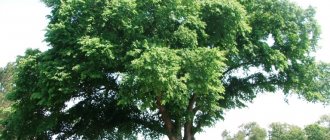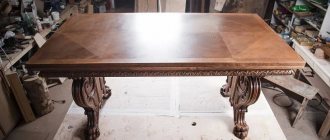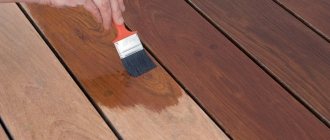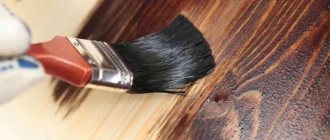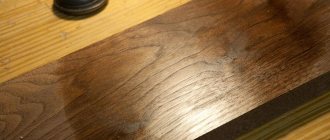Wood stain is a composition with tinting properties. It is used for processing wood; under the influence of stain, the wood changes its shade. Also used when working with fiberboard, chipboard, plywood, MDF. There are two separate types: for indoor and outdoor work. A pigment is added to compositions for external use, which protects the coating from fading when exposed to ultraviolet rays.
Water based stain
Paints wood in completely different shades: from light to the darkest. Of the existing species, it is the most common. Available in liquid or dry (powder form). The use of powder requires dilution in warm water before starting work; the liquid composition is sold in finished form.
A huge plus when working with such a stain is that it has no odor. This is a very important factor when working indoors. However, it takes 12 or more hours to dry. It can lift wood fibers; additional sanding of the wood will be required.
After processing, varnishing will be required. Acrylic stain belongs to the same type of composition. It is somewhat more convenient to work with, but it is also more expensive.
How to make it yourself
You can prepare a simple stain for wood processing at home:
- from plant ingredients;
- from tea and coffee products;
- from chemical components.
Based on plant materials
- Decoction of onion peels to obtain a bright red hue.
- A decoction of walnut peels to obtain a rich brown hue. To do this, the shell is crushed to a powder and boiled for 12 minutes in water. Add 1 tsp to the finished strained broth soda _ To obtain a red tint, potassium bichromate is added instead of soda; for a gray color, vinegar essence is added.
- Decoctions of oak, willow and alder bark give a rich black color.
- A decoction of buckthorn berries will paint the wood an attractive golden color.
From coffee, tea and vinegar essence
- To get a rich brown tint, it is enough to combine natural ground coffee and soda .
- To stain light wood, you can use a strong brew of black tea .
- To obtain a deep black shade, you need to place metal nails in a container and fill them with acetic acid . Leave for 5-7 days in a dark place.
Based on chemical components
- The brown tint is obtained after treating the wood with a solution of slaked lime .
- A deep cherry tint is achieved by applying a solution of potassium permanganate . To do this, you will need 60 g of potassium permanganate, which is diluted with a liter of heated water.
- A rich yellow tint is obtained by treating the surface with a decoction of barberry roots , to which alum is added.
- The herbal color will be obtained by combining 60 g of verdigris and vinegar essence . The mixture is boiled for 10 minutes.
- The dark brown color is obtained by combining wolfberry with copper sulfate . Glauber's salt with these berries gives a red color, and soda gives a blue tint.
With whitening effect
Bleaching stains are used as a base before painting wood, allowing you to achieve unusual color solutions . For example, apple wood can acquire a noble milky hue, and walnut can acquire a red or light pink color.
Whitening stains can be prepared as follows:
- Composition based on oxalic acid. To do this, 6 g of acid is diluted with 120 g of warm water. The finished stain is suitable for processing light or bleached wood. After application, the surface is thoroughly washed with the following solution: 4 g of soda and 16 g of lime are diluted in 110 g of water.
- Hydrogen peroxide based solution. To do this, you will need a 30% peroxide solution, which is available for sale at any pharmacy. It is suitable for bleaching various types of wood. However, it should not be used on oak, rosewood or mahogany.
Oil stain
It is a composition of a mixture of oil and dyes. The most commonly used oil is flaxseed. Distinctive features are easy and uniform application, ease of use, it does not have the property of lifting wood fibers. The dyes in the composition are highly resistant to light and are not subject to fading.
The original surface color retains its brightness for a very long period. The coating is resistant to temperature changes and perfectly protects the wood from moisture.
As for application, you can use a spray gun, brush or rag. The stain dries quickly, within 2-4 hours. Excellent for restoration and minor touch-ups.
Dealing with defects
It happens that the stain is applied to the surface incorrectly. Here are the main ways to eliminate defects:
- For numbness. Immediately after tinting the wood, you need to cover the area with varnish, which will dissolve the stain. Then clean the treated area with a rag. When the drip has already dried, it will have to be softened with white spirit or ground off with sandpaper.
- For stains. If we are talking about plywood, you will have to remove all the veneer using a plane. Solid wood is also processed with this tool, removing the thin top layer.
How can I remove stain?
The easiest way to remove water stain from your hands or treated wood. Of course, you can only remove the top layer, because such stains are distinguished by deep penetration. Stained clothes can be washed with regular powder, then rinsed with conditioner. If necessary, use oxygen bleaches, and chlorine bleaches on white items.
If stain gets on linoleum, wipe off the stain with acetone or white spirit. You must work carefully so as not to discolor the surface of the material. You can get rid of stain stains on the skin using vegetable oil or by frequently washing your hands with soap. It is much more difficult to remove non-aqueous types of stains from surfaces; you will have to remove the top layer of wood along with the tinting coating.
Nitromordant
It is produced on the basis of solvents, the properties and action are almost similar to alcohol. It dries quickly, forming a coating that is resistant to sunlight. It must be applied with a spray to avoid unevenness and differences in tone when painting.
Application Tips
The most effective and simplified method of applying stain is spraying. This technique is considered to be of very high quality, since the coating in such cases lies on the surface as evenly as possible. Using this method, you can coat both regular wood and plywood.
If the wooden product is not large in size, you can spread colored stain over it using a roller.
A brush is also a popular method of coating, but it is not always suitable for quick-drying solutions, since they can leave streaks behind if the surface is not painted as quickly as possible. It is difficult to say which coloring method is right for you. Here you should proceed from what material you will be covering, and what composition of stain you will use.
- When diluting and applying this or that mixture, be sure to read the instructions that come with the product. Do not forget about safety precautions and be sure to use protective gloves.
- The number of layers of stain will depend on how intense the shade you want to achieve.
- When processing wood, especially when it comes to coniferous species, do not forget that it must first be deresined. Also, many experts believe that it is best to apply stain along the grain of the wood.
- Powdered mixtures should be dissolved only in clean and distilled water.
- In order for the stain to penetrate as deeply as possible into the structure of the wood, many professionals recommend heating the ready-made mixture. Some stains are added to varnishes for painting wood. The same effect is obtained, but with improved protective properties. However, this technique does not work with all types of stains. Information on this issue should be clarified with store consultants.
To learn how to choose a stain for interior woodwork, see the following video.
Selection of stain color for wood
In accordance with the international color classification, each stain is assigned its own code, as well as a name identical to the type of wood whose shade you will get by applying the composition. But if you choose a stain only based on the name on the label, you risk encountering an unexpected result. This can happen for various reasons.
Manufactured by different manufacturers, stains of the same color can give a different shade. Specialty stores have samples of wood painted with various types of stain. They convey the color as accurately as possible, in contrast to the picture presented on the label, so it is better to focus on them.
Any wood has its own special color, density and texture. All these factors influence the final result, and coloring may not give exactly the effect you expected.
The darker the shade of the wood itself, the darker the resulting color when using the same stain.
Take porosity into account: the softer the wood, the more intense the staining result you will get. The composition will penetrate deeper and faster into the porous structure. If you compare, for example, pine and maple, pine is more porous, and accordingly, the staining results will be different.
The structure of the wood in the form of a natural pattern (veins) also matters when painting, affecting the intensity of the result. For example, when painting oak, pigments easily penetrate deep into the veins, causing them to darken faster than the rest of the wood. The shade on the veins will look more saturated.
Before starting work, it is advisable to carry out a color test on a separate board, processed in the same way as the material for painting. First, treat the entire board in one layer, then apply a second layer to 2/3 of the part, and a third to 1/3. You can see how suitable the composition is for a particular surface.
Tinting effects
Depending on the palette of shades used, the type of stain and the desire of the craftsman, you can give the wood a variety of effects. Due to the latter, design possibilities are greatly expanded.
Whitening process
White color is very popular in the interior. In addition, with the help of bleaching, you can restore the normal appearance of old wood, which has lost its attractiveness, but has acquired dark, bluish spots. You can also decorate some interior elements, for example, cover photo frames and paintings with bleaching stain.
Embossed white products that have been treated with special brushes look beautiful (this removes too soft fibers). After finishing the processing, they are covered with a white, light walnut stain. To protect the wood from the influence of atmospheric factors, you can apply white wax on top.
Aging of wood
An interesting option for finishing wood is to give it an aged effect. First, the product must be prepared: remove dirt, sand it, brush off dust. Then a water-based stain in white or another light color is applied to the wood. The freshly applied mixture is removed from some areas with strokes using a sponge. After drying, a finishing coat based on organic solvents is required, and to fix the shade, the pores are filled with shellac primer or wood varnish.
In addition to this method of making wood look old, there is another popular method. First you need to apply white stain, after drying, sand the product, then gently rub in dark wax. This will enhance the impression of great “age” of the coating and bring it closer to the “bleached oak” shade.
Imitation ebony
For this purpose, dark stains are used, which are marked accordingly. The wood is first sanded and polished to achieve maximum aesthetic effect. Then the stain is applied, performing one or two layers. In order for the surface to resemble a black mirror with knots appearing, you need to choose the hardest, most dense, finely porous rocks.
Giving other shades
Depending on the style, features of the interior or landscape, you can give wooden structures a variety of colors. It is only important that they all fit well with each other and do not conflict. The most commonly used non-wood shades are:
- blue - sometimes used as the main coating of finished products, pieces of furniture, gives them a very expressive look, goes well with white and yellow tones;
- gray – used in combination with bright accents, otherwise the product will turn out faceless; if there is an abundance of gray in the interior, there is a risk of depression;
- red – helps to highlight one or more elements from the total mass.
Some people try to save money and paint the wood themselves. Instead of stain, onion peels, alum, infusion of walnuts and other “folk remedies” are used. Unfortunately, the effect is rarely lasting, so it is better to purchase a high-quality composition that will last a long time and without complaints.
